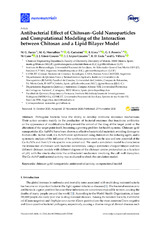Antibacterial E ect of Chitosan–Gold Nanoparticles and Computational Modeling of the Interaction between Chitosan and a Lipid Bilayer Model
Autor
Fuster, M.G.
Montalbán, M.G.
Carissimi, G.
Lima, B.
Feresin, G.E.
Cano, Manuel
Giner-Casares, Juan J.
López-Cascales, J.J.
Enriz, R.D.
Víllora, G.
Editor
MDPIFecha
2020Materia
Chitosan-gold nanoparticleAntimicrobial activity
Computational model
METS:
Mostrar el registro METSPREMIS:
Mostrar el registro PREMISMetadatos
Mostrar el registro completo del ítemResumen
Pathogenic bacteria have the ability to develop antibiotic resistance mechanisms. Their action consists mainly in the production of bacterial enzymes that inactivate antibiotics or the appearance of modifications that prevent the arrival of the drug at the target point or the alteration of the target point itself, becoming a growing problem for health systems. Chitosan–gold nanoparticles (Cs-AuNPs) have been shown as effective bactericidal materials avoiding damage to human cells. In this work, Cs-AuNPs were synthesized using chitosan as the reducing agent, and a systematic analysis of the influence of the synthesis parameters on the size and zeta potential of the Cs-AuNPs and their UV-vis spectra was carried out. We used a simulation model to characterize the interaction of chitosan with bacterial membranes, using a symmetric charged bilayer and two different chitosan models with different degrees of the chitosan amine protonation as a function of pH, with the aim to elucidate the antibacterial mechanism involving the cell wall disruption. The Cs-AuNP antibacterial activity was evaluated to check the simulation model.

